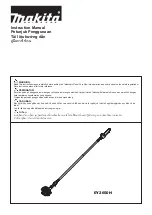
English - 3
■
In case the saw blade jams or if the sawing
is discontinued, switch the saw off and
hold it motionless in the material until the
blade comes to a complete stop. Never at-
tempt to remove the saw from the work or
pull the saw backward while the blade is in
motion or kickback may occur. Investigate
and take corrective action to eliminate the
cause of the blade binding.
■
When restarting a saw in the workpiece,
centre the saw blade in the kerf and check
that the saw teeth are not engaged into the
material. If the saw blade is binding, it may
travel up from the workpiece or kickback as the
saw is restarted.
■
Support large panels to reduce the risk of
blade pinching and kickback. Large panels
tend to sag under their own weight. Sup-
ports must be placed under the panel on both
sides, near the line of cut and near the edge of
the panel.
■
Do not use dull or damaged saw blades.
Unsharpened or improperly set blades pro-
duce narrow kerf causing excessive friction,
blade binding and kickback.
■
Before sawing, tighten the blade depth and
cutting angle adjustments. If the adjust-
ments change during cutting, the saw blade
can jam and kickback can occur.
■
Use extra caution when making “plunge
cuts” into existing walls or other blind ar-
eas. The protruding saw blade, when running
into hidden objects, can be jammed and cause
kickback.
■
Check the lower guard for proper closing
before each use. Do not operate the saw if
the lower guard does not move freely and
close instantly. Never clamp or tie the
lower guard into the open position. If saw is
accidentally dropped, the lower guard may be
bent. Raise the lower guard with the retracting
handle and make sure it moves freely and
does not touch the blade or any other part, in
all angles and depths of cut.
■
Check the operation of the lower guard
spring. If the guard and the spring are not
operating properly, they must be serviced
before use. The lower guard may operate
sluggishly due to damaged parts, gummy de-
posits or a build-up of debris.
■
The lower guard should be retracted manu-
ally only for special cuts such as “plunge
cuts” and “compound cuts”. Raise the
lower guard with the retracting handle and
as soon as blade enters the material, the
lower guard must be released. For all other
sawing, the lower guard must operate auto-
matically.
■
Always observe that the lower guard is
covering the saw blade before placing
down the saw on a workbench or the floor.
An unprotected, coasting blade will cause the
saw to travel backwards, cutting whatever is in
its path. Be aware of the run-on period of the
saw.
■
Do not reach into the saw dust ejector with
your hands. They could be injured by rotating
parts.
■
Do not work overhead with the saw. In this
manner you do not have sufficient control over
the power tool.
■
Use suitable detectors to determine if util-
ity lines are hidden in the work area or call
the local utility company for assistance.
Contact with electric lines can lead to fire and
electric shock. Damaging a gas line can lead
to explosion. Penetrating a water line causes
property damage or may cause an electric
shock.
■
Do not operate the power tool stationary. It
is not designed for operation with a saw table.
■
Do not use high speed steel (HSS) saw
blades. Such saw blades can easily break.
GKS 65:
The machine is intended for lengthways and
crossways cutting of wood with straight cutting
lines as well as mitre angles to 45° while resting
firmly on the work piece.
GKS 65 CE:
The machine is intended for lengthways and
crossways cutting of wood with straight cutting
lines as well as mitre angles to 45° while resting
firmly on the work piece. With suitable saw
blades, non-ferrous metal, light building materials
and plastic can also be sawed.
Intended Use
1 609 929 H32.book Seite 3 Mittwoch, 20. April 2005 7:56 07
16 • 1 609 929 H32 • 05.04
















































